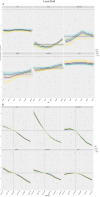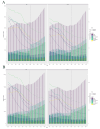The global burden of cardiovascular disease attributable to diet low in fiber among people aged 60 years and older, 1990-2019: an age-period-cohort analysis of the global burden of disease study
- PMID: 39333980
- PMCID: PMC11438263
- DOI: 10.1186/s12889-024-19897-6
The global burden of cardiovascular disease attributable to diet low in fiber among people aged 60 years and older, 1990-2019: an age-period-cohort analysis of the global burden of disease study
Abstract
Objectives: This study aimed to quantify the global cardiovascular disease (CVD) burden attributable to diet low in fiber among adults aged 60 years and older using data from the Global Burden of Disease (GBD) Study 2019.
Methods: We extracted data on CVD mortality, disability-adjusted life-years (DALYs), and risk-factor exposures from the GBD 2019 study for people aged 60 and older. Age-period-cohort models were used to estimate the overall annual percentage change in mortality and DALY rate (net drift, % per year), mortality and DALY rate for each age group from 1990 to 2019 (local drift, % per year), longitudinal age-specific rate corrected for period bias (age effect), and mortality and Daly rate for each age group from 1990 to 2019 (local drift, % per year). And period/cohort relative risk (period/cohort effect).
Results: From 1990 to 2019, global age-standardized cardiovascular disease (CVD) mortality rates attributable to low dietary fiber intake decreased by 2.37% per year, while disability-adjusted life years (DALYs) fell by 2.48% annually. Decreases were observed across all sociodemographic index regions, with fastest declines in high and high-middle SDI areas. CVD mortality and DALY rates attributable to low fiber increased exponentially with age, peaking at 85-89 years, and were higher in men than women. Regarding period effects, mortality and DALY rates declined since 2000, reaching nadirs in 2015-2019. For birth cohort patterns, risks attributable to low fiber intake peaked among early 1900s births and subsequently fell, with more pronounced reductions over time in women.
Conclusions: Low dietary fiber intake is a leading contributor to the global cardiovascular disease burden, accounting for substantial mortality and disability specifically among older adults over recent decades.
Keywords: Age-period-cohort models; Cardiovascular disease; Disability-adjusted life years; GBD; Global burden of disease; Mortality.
© 2024. The Author(s).
Conflict of interest statement
The authors declare no competing interests.
Figures





References
-
- SEBASTIAN SA. Cardiovascular disease risk communication: strategies, impact, and future directions. Curr Probl Cardiol. 2024;49(5):102490. - PubMed
-
- WANG Z Q, ZHANG L, ZHENG H, et al. Burden and trend of ischemic heart disease and colorectal cancer attributable to a diet low in fiber in China, 1990–2017: findings from the global burden of Disease Study 2017 [J]. Eur J Nutr. 2021;60(7):3819–27. - PubMed
-
- DUELL PB. Triglyceride-Rich lipoproteins and Atherosclerotic Cardiovascular Disease risk [J]. J Am Coll Cardiol. 2023;81(2):153–5. - PubMed
-
- Global, regional, and national comparative risk assessment of 84 behavioural, environmental and occupational, and metabolic risks or clusters of risks for 195 countries and territories, 1990–2017: a systematic analysis for the Global Burden of Disease Study 2017, et al. Lancet. 2018;392(10159):1923–94. J. - PMC - PubMed
MeSH terms
Substances
LinkOut - more resources
Full Text Sources
Medical

